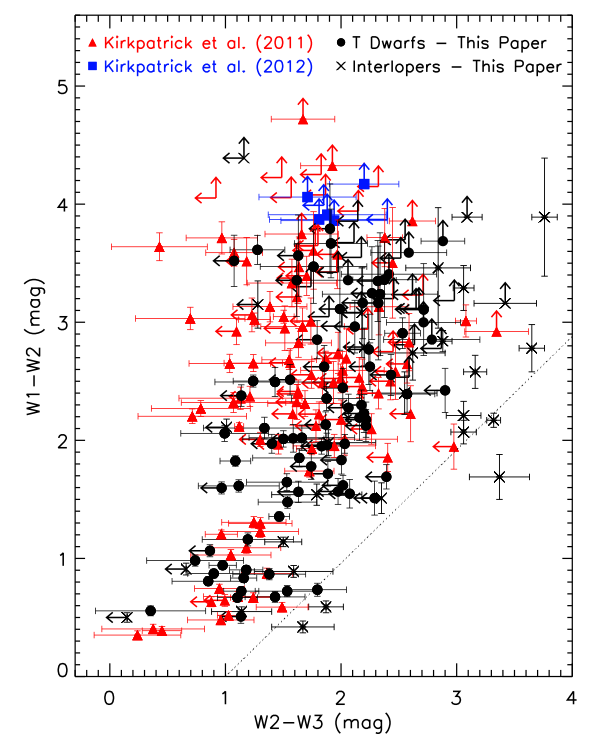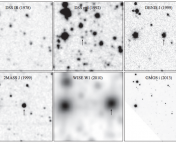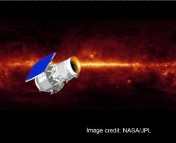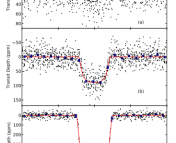- Title: A Study of the Diverse T Dwarf Population Revealed by WISE
- Authors: G.N Mace, J.D. Kirkpatrick, M.C. Cushing et al.
- First Author’s Home Institution: UCLA
NASA’s Wide-field Infrared Survey Explorer (WISE) is an infrared survey telescope that scanned the entire sky in six month periods. From December 2009 until February 2011, WISE imaged the sky in four infrared photometric bands. As an infrared mission, WISE was designed to see objects such as brown dwarfs, interstellar dust, or asteroids that are brightest in the infrared part of the electromagnetic spectrum. The WISE All-Sky Source Catalog contains all the observations WISE made over its mission. Astronomers are now combing through this catalog to find new and exciting things.
Brown dwarfs are stellar-like objects that do not have enough mass to begin fusing hydrogen, though some can fuse deuterium. Their masses range from about 13 Jupiter masses up to about 80 Jupiter masses, or 0.013 M⊙ to 0.08 M⊙. Since they were first detected in 1988, the OBAFGKM classification (developed in the early 1900’s) does not include brown dwarfs. Thus, the lesser known L, T, and Y classifications to designate brown dwarfs have since been added, in order of decreasing effective temperature. Before WISE, only about 70 T dwarfs were known. This paper presents the discovery of 87 new T dwarfs found in WISE data.
T dwarfs were first observed in 1995, and various surveys including 2MASS, UKIDSS, and CFHTLS have slowly discovered more. Methane is prominent in the spectra of T dwarfs, which have temperatures between ~500 K and ~1300 K. WISE imaged the sky in four infrared bands, referred to as W1, W2, W3, and W4. Because stars emit approximately as blackbodies, different spectral types will have different luminosities in various bands. Astronomers refer to the difference in luminosity between two different photometric bands as colors. As an example, the HR diagram can be plotted using colors such as B-V instead of temperature. Quantifying these differences to create color diagrams helps astronomers search for different objects.

Here is the color-color diagram used in this paper to identify new T dwarfs.The red triangles and blue squares show T dwarfs found in previous searches. Black circles are the T dwarfs first presented in this paper. Limits on each source are denoted by arrows or bars. The dotted line in the bottom right is the cut-off limit where sources might be extraglactic. The axes show the limits of W1-W2 and W2-W3 the authors required for the data.
For this paper, the W1-W2 and W2-W3 colors are sensitive to the amount of methane present in a source. By searching through the catalog for sources with specific color differences, the authors found sources believed to be T dwarfs. The limits of the colors were carefully selected to exclude sources that are extragalactic or from star-forming regions. After these limits were applied, the authors created finder charts for each source to double check that that it was point-like and did not appear in visual wavelength images.
With this selection done, the authors proceeded to obtain additional photometry with other telescopes to provide additional constraints on the objects believed to be T dwarfs. 90 sources were selected to obtain follow-up data. Infrared spectroscopy was obtained to determine exact spectral classifications for each T dwarf. These spectra were compared to T0-T8 standard star spectra to determine the classifications. Recall that for spectral classification, the numbers subdivide each letter into ten bins, where lower numbers correspond to hotter stars. Slight differences in each spectral class allow new observations to be compared to prototype stars for each class.
After all these classifications were complete, there were still three sources that could not be classified. The authors considered that they were L dwarfs, but the spectral type did not match known spectra of L dwarfs. Upon investigating the data some more, it was noticed that all three objects showed some variability in the WISE data. It is hypothesized that these changes are either caused by atmospheric changes on the T dwarf or that these systems are actually binaries with unresolved L dwarfs in addition to a T dwarf.
Between an earlier paper and these 87 new T dwarfs, WISE has now tripled the number of known T dwarfs with spectral type later than T5. As we continue to know about more brown dwarfs of various spectral types, we will be able to create better models of how these failed stars form and understand the unique atmospheres they have. Once we can understand these things, perhaps we will know if brown dwarfs can host habitable planets!




